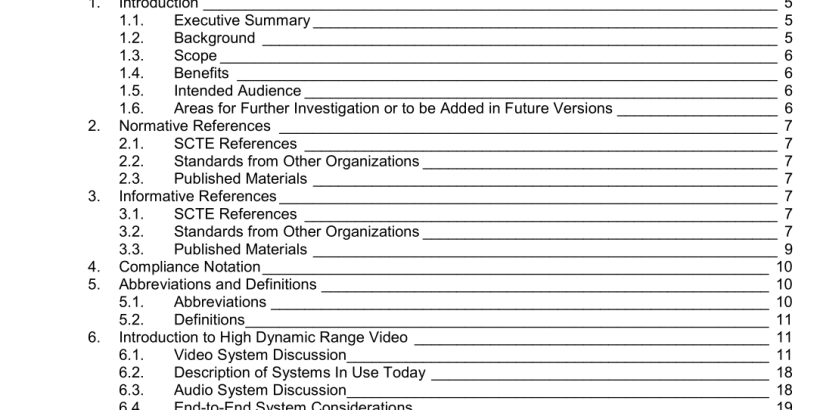ANSI SCTE 247-2018 pdf download.High Dynamic Range (HDR) Video: System Requirements for Cable
1.1. Executive Summary
The consensus of the drafting group members is that HDR10 is appropriate for use in the cable industry for a “first pass” HDR video distribution option against the time constraints larger operators desire to meet. Other existing HDR formats used for content or advertising production have appropriately defined conversion methods that allow other options to be used but translated for cable distribution. HDR10 is used by both Blu-ray and Internet streaming providers, which ensures the availability of high-quality content in the format and the availability of technical systems products that will meet the needs of the cable industry. HDR10 processing and display is supported across the widest variety of currently available and next-generation television, computer, tablet, and phone devices. Its performance many be improved in the future with the optional inclusion of dynamic metadata, as the ability to create and deliver it becomes a practical possibility in the content production and distribution ecosystem. SCTE should proceed expeditiously to document HDR10 for cable systems to address initial industry launch demands while continuing work to consider other HDR options for use in cable where appropriate. The HLG HDR system, which operates simply without HDR metadata of any kind to complicate the various cable system workflow and processing systems, is also a potentially valid solution to some of the issues identified in this document, and should be evaluated along with other HDR systems and metadata based enhancements to HDR10 in future phases of HDR standardization.
1.2. Background
From origins using an ‘amplified pipe’ for the distribution of off-air television signals, the cable industry has successfully adopted, evolved and innovated distribution technologies used to provide information and entertainment services to consumers. Like the change from analog to digital audio and video formats, the nature of cable technology has been to embrace potentially disruptive and different technologies – but deploy those technologies to consumers in what is actually a more measured evolution. Next-generation video services and related consumer product offerings are disruptive and quite varied in their technical nature. In the context of this document — and requirements within — the reader should use care to understand the context of the advanced services – high dynamic range (HDR) video services are potentially only one component of a next-generation consumer offering, perhaps combined with wide color gamut (WCG), and possibly higher-resolution ultra-high definition video (UHD) and higher frame rate (HFR) video. The objective of this requirements document is to define the technical elements of next-generation video systems that are necessary for the cable industry. These technical details will enable proponents and designers to specify a system necessary to support a product offering that can be standardized and deployed via cable systems to consumers. Use of the singular ‘system’ in the preceding paragraph is further detailed in the document – additional features and evolution of next-generation technologies may occur over time, however, the intent of this document is to provide a narrow and succinct choice of parameters that will enable an initial launch to consumers with a stable platform and provide future-proof evolutionary paths toward enhancements. Generally, and colloquially, that evolution could be referred to as ‘crawl, walk, run.’
The use of these standards by cable operators’ ecosystem partners necessitates considerations about interoperability and technical interfaces among content creators, programmers, broadcasters and cable operators of varying size and technical infrastructure. Cable content shall interoperate smoothly with consumer electronics devices. These format discussions have both technical and business ramifications. This document does not intend to codify those specifications. However, for clarity and information, those ecosystem components may be described herein.ANSI SCTE 247-2018 pdf download
